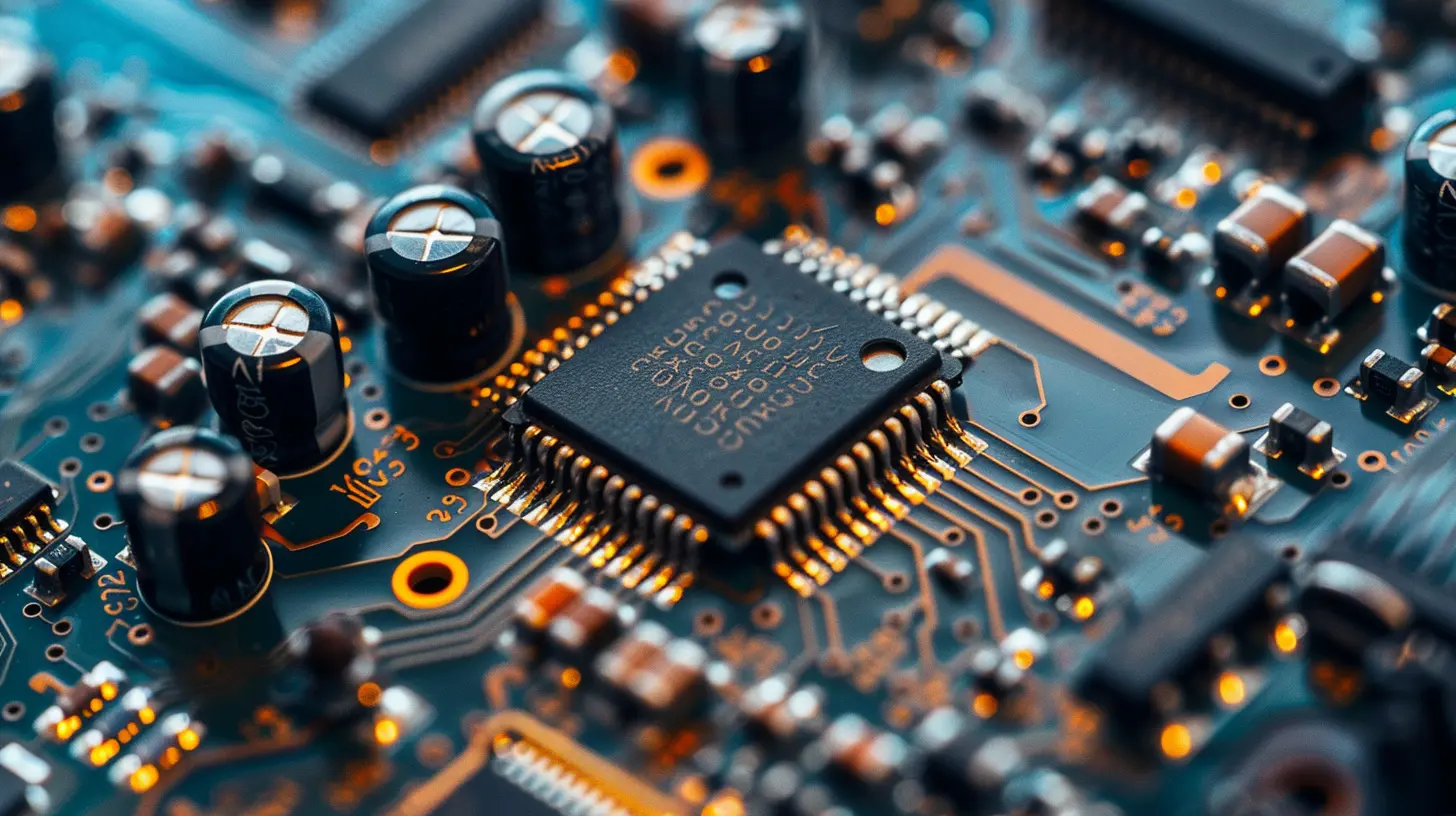Quantum Computing Hardware: A Look at Emerging Technologies
19 December 2024
In recent years, the buzz surrounding quantum computing has exploded, with many experts predicting that it could revolutionize industries from pharmaceuticals to financial modeling. But what makes quantum computing so special? More importantly, how is the hardware that powers these machines evolving? When we talk about quantum computing, we often dive deep into the theory, algorithms, and potential applications, but the hardware is just as fascinating — and critical to making it all work.
Let’s take a closer look at quantum computing hardware and explore some of the emerging technologies that are pushing this field forward.

What is Quantum Computing?
Before we dive into the hardware, let’s take a quick refresher on what quantum computing is all about. Traditional computers process information using binary bits — ones and zeros. Quantum computers, on the other hand, use quantum bits, or qubits. Qubits can exist in multiple states simultaneously, thanks to the principles of quantum mechanics like superposition and entanglement. This allows quantum computers to perform calculations at speeds unimaginable to classical computers.In theory, quantum computers could solve problems that would take classical computers thousands (or even millions) of years to compute. This is why there’s such a race to develop practical quantum hardware.
The Challenge of Building Quantum Computers
Sounds amazing, right? But here’s the catch: building a functional quantum computer is no easy feat. Quantum systems are incredibly delicate, and the slightest interference from the external environment can cause errors in calculations. This phenomenon is known as "quantum decoherence." To make things worse, qubits need to operate at temperatures close to absolute zero (-273.15°C), making the hardware setup both complex and expensive.This brings us to the core of the discussion — the different approaches that scientists and engineers are taking to build quantum hardware. Let’s dive into some of the most promising technologies.

Superconducting Qubits: Leading The Charge
One of the most popular and widely researched methods for quantum computing hardware involves superconducting qubits. Big players like Google, IBM, and Rigetti are all in on this technology, and for good reason. Superconducting qubits are created using materials that exhibit zero electrical resistance at extremely low temperatures.How It Works
The idea behind superconducting qubits is to trap currents in small circuits. These circuits can exist in multiple states simultaneously due to quantum superposition. By carefully managing these states, you can perform quantum computations.Many of the quantum computers currently in operation (like IBM's Q System One) use superconducting qubit technology because it’s relatively scalable. However, there are still challenges to overcome, such as noise and decoherence, which can lead to computational errors.
Pros
- Scalability: Superconducting qubits are easier to scale compared to other quantum technologies.- Development: Big companies are heavily invested in this technology, speeding up advancements.
Cons
- High Maintenance: Requires extremely low temperatures to function.- Error Rates: Susceptible to decoherence and noise, leading to errors.

Trapped Ions: The Dark Horse of Quantum Hardware
While superconducting qubits get much of the spotlight, trapped ions are another promising technology for quantum computing. Companies like IonQ are betting on this technology to lead the future of quantum machines.How It Works
In trapped ion quantum computers, individual ions (charged atoms) are suspended in electromagnetic fields. These ions are then manipulated using lasers to perform quantum computations. The ions' quantum states can be entangled, allowing for the parallel processing power that quantum computers are famous for.Pros
- Stable: Trapped ions are more stable than superconducting qubits, meaning they experience less decoherence.- Longer Coherence Times: The quantum information in trapped ions can last longer, leading to fewer errors during computations.
Cons
- Slow: Trapped ion operations are generally slower compared to superconducting qubits.- Scalability: While trapped ions are more stable, scaling up the number of qubits is more challenging than with superconducting qubits.

Topological Qubits: The New Kid On The Block
Now, let’s talk about a technology that’s still in its early stages but has the potential to be a game-changer: topological qubits. Microsoft is one of the few companies exploring this technology, and they believe it could lead to more stable and error-resistant quantum computers.How It Works
Topological qubits rely on the unique properties of quasiparticles that exist in two-dimensional materials. Without getting too technical, these quasiparticles are braided around each other to create quantum states that are less prone to error. Because of their topological nature, these qubits are theoretically much more robust against decoherence.Pros
- Error Resistance: Topological qubits are less affected by environmental noise, potentially reducing the error rates significantly.- Scalability: If it works, topological qubits could be easier to scale than other types of qubits.
Cons
- Experimental: This technology is still very much in the research phase, and no practical quantum computer has been built using topological qubits yet.- Complexity: The underlying physics behind topological qubits is extremely complex, making it harder to develop.
Photonic Quantum Computing: Computing at the Speed of Light
Another fascinating approach to quantum hardware involves using photons (particles of light) to perform quantum computations. Companies like Xanadu are developing photonic quantum computers, which could open new doors in quantum research.How It Works
In photonic quantum computing, information is encoded in the quantum states of individual photons. These photons are then manipulated using devices like beamsplitters and phase shifters to perform computations. One of the biggest advantages of this approach is that photons don’t need to be kept at ultra-low temperatures like other qubit types.Pros
- Room Temperature: Photonic quantum computers can operate at room temperature, which simplifies the hardware requirements.- Fast: Since photons travel at the speed of light, computations can be extremely fast.
Cons
- Fragility: Photons are difficult to control, and the technology is still in its infancy.- Scaling Issues: Building a large-scale photonic quantum computer is still a massive challenge.
Spin Qubits: Quantum Computing in Your Pocket?
Imagine a quantum computer that fits in the palm of your hand. While we’re not quite there yet, researchers are working on spin qubits, a technology that could make quantum computers much more compact and efficient.How It Works
Spin qubits are based on the quantum mechanical property known as "spin," which can be thought of as the intrinsic angular momentum of particles like electrons. By controlling the spin states of individual electrons trapped in quantum dots, researchers can create qubits. The beauty of spin qubits is that they could eventually be integrated into traditional semiconductor materials, enabling quantum computing chips similar to those used in today’s classical computers.Pros
- Compact: Spin qubits could potentially be integrated into devices much smaller than current quantum computers.- Compatibility: They could work alongside traditional semiconductor technology, making it easier to integrate quantum computing into existing hardware.
Cons
- Error Rates: Like other qubit types, spin qubits are prone to decoherence.- Development Stage: The technology is still in its experimental phase and far from practical implementation.
The Future of Quantum Computing Hardware
So, what does the future hold for quantum computing hardware? While no one can say for sure, it’s clear that multiple approaches are being pursued, each with its own set of advantages and challenges. Superconducting qubits currently lead the pack, but trapped ions, topological qubits, and even photonic quantum computers are all promising contenders.The race is on to build quantum computers that are not only powerful but also practical and scalable. Whoever cracks the code first could reshape industries and redefine the limits of computation as we know it. But one thing is certain: we’re just scratching the surface of what’s possible with quantum hardware.
Conclusion: The Quantum Hardware Race is Just Beginning
Quantum computing hardware is evolving rapidly, with new technologies emerging every year. Whether it’s superconducting qubits, trapped ions, or even photons, each approach has unique strengths and weaknesses. While we’re still in the early stages of this technological revolution, the potential is enormous. As hardware continues to improve, we’ll inch closer to a future where quantum computers can tackle real-world problems that are beyond the reach of classical machines.For now, the quantum hardware race is wide open. And who knows? The quantum computer of the future might be powered by a technology that hasn’t even been invented yet.
all images in this post were generated using AI tools
Category:
Quantum ComputingAuthor:

Reese McQuillan
Discussion
rate this article
24 comments
Soryn Mendez
This article offers valuable insights into the latest advancements in quantum computing hardware, highlighting key innovations and their potential to revolutionize computing efficiency and problem-solving capabilities.
February 10, 2025 at 8:17 PM

Reese McQuillan
Thank you for your feedback! I'm glad you found the insights on advancements in quantum computing hardware valuable.
Kaleb Hayes
Exciting advancements ahead! These technologies promise to revolutionize our computational capabilities.
January 31, 2025 at 9:35 PM

Reese McQuillan
Thank you! We're indeed on the brink of a technological revolution that could reshape the future of computation.
Zevros McGrath
This article offers a fascinating glimpse into the future of quantum computing. It's exciting to see how emerging technologies can reshape our understanding and capabilities, bringing both opportunities and challenges. Thank you for sharing these insights!
January 25, 2025 at 8:20 PM

Reese McQuillan
Thank you for your thoughtful comment! I'm glad you found the insights on quantum computing engaging. Exciting times ahead!
Franklin McLemore
Exciting advancements ahead! Quantum hardware is poised for breakthroughs.
January 21, 2025 at 1:52 PM

Reese McQuillan
Thank you! Exciting times indeed as quantum hardware continues to evolve and unlock new possibilities.
Cadence Kane
This article provides an insightful overview of the latest trends in quantum computing hardware. The exploration of emerging technologies highlights promising advancements that could revolutionize computing capabilities in the near future.
January 17, 2025 at 1:53 PM

Reese McQuillan
Thank you for your positive feedback! I'm glad you found the exploration of emerging technologies insightful.
Zorina Wright
Quantum computing hardware: where electrons play hide and seek and qubits have more drama than a soap opera! As we peek into emerging technologies, let’s just hope our computers don’t start developing existential crises. After all, we just want to solve problems, not add to them—right?
January 13, 2025 at 8:38 PM

Reese McQuillan
Absolutely! The complexities of quantum computing do feel like a dramatic narrative, but ultimately, our goal is to harness these technologies to tackle real-world challenges. Let's keep the existential crises to a minimum!
Josie McKellar
Exciting advancements; potential breakthroughs ahead!
January 11, 2025 at 12:22 PM

Reese McQuillan
Thank you! The future of quantum computing is indeed promising, and we're just scratching the surface of its potential.
Lisa Pratt
Quantum computing is not just the future; it's the now. Emerging technologies are redefining what's possible, and those who fail to adapt will be left in the dust. Embrace innovation!
January 9, 2025 at 3:53 AM

Reese McQuillan
Absolutely! Quantum computing is already making strides today, and embracing these innovations is crucial for staying competitive in a rapidly evolving landscape.
Barbara Moses
Exciting times ahead! Quantum tech is shaping our future! 🚀
January 5, 2025 at 7:32 PM

Reese McQuillan
Absolutely! Quantum tech holds incredible potential for innovation and transformative advancements. Exciting indeed! 🚀
Carla McGowan
Exciting times ahead for innovation!
January 2, 2025 at 4:24 AM

Reese McQuillan
Absolutely! The potential of quantum computing is only beginning to unfold, promising transformative advancements across various fields.
Brianna McKinnon
Great overview of the evolving quantum landscape! Exciting to see how these technologies will shape the future.
December 30, 2024 at 5:33 AM

Reese McQuillan
Thank you! I’m glad you found it insightful—exciting times indeed for quantum technologies!
Destiny Vaughn
This article effectively highlights the potential of emerging quantum computing technologies, but it leaves me curious about their practical applications and challenges.
December 25, 2024 at 7:59 PM

Reese McQuillan
Thank you for your insightful comment! I appreciate your curiosity, and I plan to explore practical applications and challenges in future articles. Stay tuned!
Monica Hill
As we stand on the precipice of a quantum revolution, emerging hardware technologies hold secrets that could redefine computation. Will these advancements unlock the mysteries of the universe, or will they lead us down a path of unintended consequences? The future is quantum, and it's shrouded in enigma.
December 25, 2024 at 11:46 AM

Reese McQuillan
The quantum revolution promises transformative advancements in computation, but navigating its complexities responsibly is crucial to harnessing its full potential.
Tank Whitaker
The article effectively highlights key advancements in quantum hardware, emphasizing both potential and technical challenges ahead.
December 25, 2024 at 3:20 AM

Reese McQuillan
Thank you! I'm glad you found the article insightful regarding both the advancements and challenges in quantum hardware. Your feedback is appreciated!
Kevin McKellar
Exciting times ahead in the world of quantum computing! As these emerging technologies take shape, let's embrace the future with curiosity and enthusiasm—who knows what amazing advancements await us? Keep innovating!
December 24, 2024 at 9:59 PM

Reese McQuillan
Thank you! The future of quantum computing is indeed promising, and I appreciate your enthusiasm for these groundbreaking advancements!
Signe Mendez
Exciting advancements! Understanding quantum computing's potential can inspire hope for transformative solutions ahead.
December 23, 2024 at 1:35 PM

Reese McQuillan
Thank you! I'm glad you find the advancements inspiring. Quantum computing holds great promise for revolutionizing various fields.
Zephira Coleman
Quantum computing is not just a buzzword; it's the future. Emerging technologies are reshaping the landscape, promising unprecedented computational power. Embrace the revolution or get left behind—this is the dawn of a new computing era.
December 22, 2024 at 4:13 AM

Reese McQuillan
Thank you for your insightful comment! Indeed, quantum computing holds immense potential to transform the tech landscape and drive innovation. Embracing these developments is crucial for staying ahead in the rapidly evolving digital age.
Faenor Dodson
This article provides a concise overview of the latest advancements in quantum computing hardware, highlighting both the promising potential and the challenges ahead in this rapidly evolving field. Engaging and informative read!
December 21, 2024 at 8:33 PM

Reese McQuillan
Thank you for your feedback! I'm glad you found the article engaging and informative.
Silas McKee
Quantum computing hardware: where particles play hide and seek, and bits go on vacation! If traditional computers are the tortoise, then quantum tech is that hyperactive rabbit on espresso. Let’s just hope it doesn’t run off with our homework... or the universe while it’s at it!
December 21, 2024 at 1:56 PM

Reese McQuillan
Haha, great analogy! Quantum computing is definitely racing ahead, and it’s exciting to see where it takes us next. Let’s hope it brings us more than just chaos!
Selkie McFarlin
This article offers a concise overview of emerging quantum computing hardware technologies. It effectively highlights both the potential breakthroughs and current challenges, making it a valuable read for enthusiasts and professionals alike.
December 20, 2024 at 9:21 PM

Reese McQuillan
Thank you for your feedback! I'm glad you found the article informative and valuable.
Greta Butler
This article provides an insightful overview of emerging technologies in quantum computing hardware. It's fascinating to see how advancements could redefine computing power. However, I hope the discussion includes challenges, as understanding both sides is crucial for realistic expectations in this complex field.
December 20, 2024 at 11:56 AM

Reese McQuillan
Thank you for your thoughtful comment! I appreciate your interest in a balanced discussion, and I will certainly consider including challenges in future articles to provide a more comprehensive view of the field.
Bear Cain
Quantum computing: where bits go on vacation and qubits throw parties! Excited to see what these emerging technologies will conjure up next!
December 20, 2024 at 3:41 AM

Reese McQuillan
Thanks for the fun comment! Exciting times ahead as we explore the potential of qubits and their transformative capabilities!
Mara Sanders
Embrace the future! Quantum computing innovations will revolutionize technology and unlock limitless possibilities ahead!
December 19, 2024 at 12:20 PM

Reese McQuillan
Absolutely! Quantum computing holds immense potential to transform technology and drive groundbreaking innovations. Exciting times are ahead!
Joy Barron
This article on quantum computing hardware is fascinating! I’m eager to learn more about the specific emerging technologies that will drive this field forward. How do these innovations compare to classical computing in terms of practical applications? Are there any significant breakthroughs on the horizon that could reshape industries?
December 19, 2024 at 4:44 AM

Reese McQuillan
Thank you for your interest! Emerging quantum technologies, like superconducting qubits and topological qubits, offer advantages in processing power and speed compared to classical computing, particularly for complex simulations and optimization problems. Significant breakthroughs, such as error correction and scalable quantum networks, are on the horizon and could indeed reshape various industries.
MORE POSTS

Exploring Laptops with OLED Displays: A Visual Feast or Just a Gimmick?

Are Laptops with Detachable Screens the Future of Computing?

Blockchain in Agriculture: Ensuring Food Safety and Traceability

How Space Tourism Will Be Powered by Cutting-Edge Tech

Hidden Gems: Lesser-Known Video Editing Tools You Should Try

Why Li-Fi Could Soon Replace Wi-Fi in Your Home

Green Tech Innovations Powering the Future of Gadgets

Why Insider Threats Are the Biggest Challenge in Data Security

The Role of Biometric Sensors in Smartphone Security

How to Optimize Bluetooth Connectivity in Crowded Areas

Smart Displays and Digital Assistants: Are They Worth the Investment?

Exploring Quantum Annealing: A Specialized Approach to Quantum Computing

A Deep Dive into the Best Bluetooth Headphones for Crystal-Clear Sound

How AI Is Transforming Data Center Management